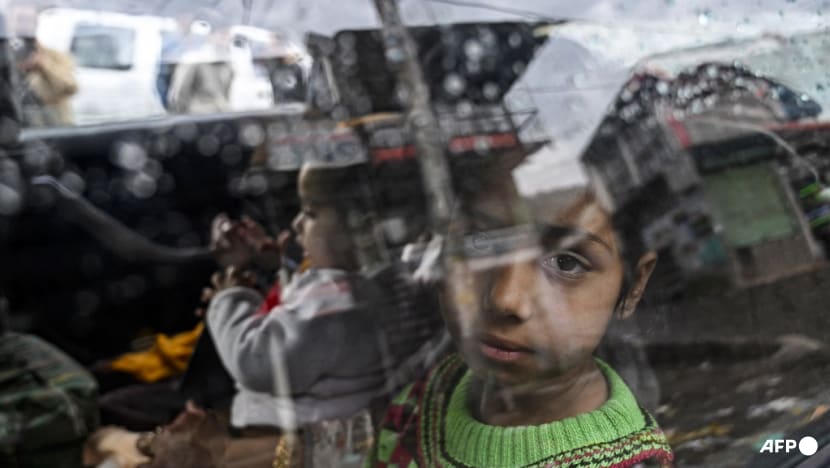Commentary: South Asia can’t unite until India and Pakistan learn to coexist
Persistent hostility between India and Pakistan derails hopes of deeper social and economic progress in South Asia, says former foreign correspondent Nirmal Ghosh.

A girl looks out the window of a car as she returns to her hometown after India-Pakistan ceasefire in Uri, about 100km from Srinagar on May 11, 2025. (Photo: AFP/Tauseef Mustafa)

This audio is generated by an AI tool.
SINGAPORE: Over a week has passed since a ceasefire pulled India and Pakistan back from the brink of a full-fledged war. For now, the fragile truce appears to be holding.
Amid the amped up din of the most recent conflict, a few key lessons emerge, which need to be recognised if the South Asian subcontinent is to at some point break out of the cycle of animosity and distrust that is holding over one billion people back from true, tangible, social and economic progress.
A comparison with ASEAN – the 10-member Association of Southeast Asian Nations – may be relevant. ASEAN, decimated by colonialism, proxy wars and civil wars, has long been derided for its apparent ineffectiveness. This is because ASEAN operates by consensus and avoids interfering in what it deems to be the internal affairs of its member states.
This does not mean it does nothing. ASEAN’s 1976 Treaty of Amity and Cooperation in Southeast Asia commits members to reject the use or threat of force and peacefully settle inter-state disputes, and in 2008 conflict between Thailand and Cambodia was successfully defused before it could escalate.
However, ASEAN has not been able to do anything about Myanmar’s civil war, whose ramifications spill over its borders and across the region. It does not present a united front in negotiating trade terms with the United States. And a Code of Conduct in the disputed South China Sea has long been kicked down the road, hostage to internal divisions in ASEAN exploited by one or other big power.
Yet, as Singapore’s former permanent secretary for foreign affairs Kishore Mahbubani tirelessly points out, ASEAN countries – even with a not very distant history of war – do not go to war with each other.
“The value of ASEAN is shown in the fact that relatively speaking this is one of the less nervous regions in the world,” said Mr Mahbubani, distinguished fellow at the Asia Research Institute of the National University of Singapore (NUS) and author of several books on geopolitics including The ASEAN Miracle (2017).
“One way or another, things are carrying on calmly,” he told me.
“If you really want to understand the significance of ASEAN, just watch what’s happening today between India and Pakistan. If you want an analogy, today the Philippines still claims the state of Sabah. But is there a danger of a war between the Philippines and Malaysia? Practically zero. Because ASEAN meetings mean that they meet all the time, they know each other, they play golf with each other. It’s a different chemistry. Even with a change of leaders, essentially the policies continue and the sense of trust between leaders is very significant.”
A RIVALRY THAT CONSUMES THE REGION
The economic and human cost of the deadly India-Pakistan rivalry (the pair have had five wars since Pakistan was cleaved off from India in 1947) is often overlooked or overridden by nationalist and territorial ambitions recently increasingly overlayed with religious zeal.
In India, a particularly assertive brand of Hindu nationalism sometimes seems to be doing its best to mirror the intolerance of what it describes as the enemy – militant, extremist Islam.
ASEAN has its ASEAN Economic Community, which envisions ASEAN as a single market and competitive product base, integrated into the global economy. It isn’t quite there yet but has been making steady progress.
In contrast, the South Asian Association for Regional Cooperation comprising Afghanistan, Bangladesh, Bhutan, India, Maldives, Nepal, Pakistan and Sri Lanka is well-known for having not lived up to its name.
The most South Asian regional cooperation structures have been able to achieve is to allow citizens of each other’s countries to visit their heritage monuments at local rates of entry.
“South Asia is the least economically integrated region in the world if we compare it to Southeast Asia, Europe or North America. Trade within the region is less than 5 per cent of the trade of these countries” says Dr Aparna Pande, research fellow and director of the Initiative on the Future of India and South Asia, at the Hudson Institute in Washington DC.
India granted Most Favoured Nation (MFN) status to Pakistan in 1996, a year after the formation of the World Trade Organization. Pakistan did not reciprocate, arguing that the Kashmir dispute needed to be resolved first.
Signing on to the South Asian Free Trade Area in 2004 produced little dividends. In February 2019, in the wake of a suicide attack claimed by Pakistan-based Jaish-e-Mohammed (Pakistan denied involvement) on an Indian security convoy in Pulwama, Kashmir, that killed 40 Indian troops, India revoked Pakistan's MFN status and raised import duty on all Pakistani goods to 200 per cent.
Unfortunately, this toxic rivalry has most recently further deepened. The decibel level of the flare-up between India and Pakistan playing out in regular and social media has been deafening. Truth, as the aphorism goes, was the first casualty. Opinions are extreme and moderate voices – let alone critics – are branded traitors.
A CONFLICT WITH NO CLEAR WINNER
Hyper-patriots may argue that there is no need for moderation. In India, one is informed that India beat up Pakistan, and will continue to do so. In this simplistic world, India – certainly the larger power – will eventually crush Pakistan.
The US-brokered ceasefire deprived India of a historic opportunity to bring Pakistan to its knees. Any suggestion that Pakistan scored its own hits is dismissed as traitorous. On the other side of the border, Pakistan won the war, teaching India a lesson.
Now the two countries are engaged in pushing their own narratives to the international community, but that will make little difference to the jingoists on the ground. At some level, leaders – both civilian and military – are compelled to assuage public opinion which once manufactured, molded and weaponised, becomes a free-roaming monster when uncaged.
Pakistan remains a military state, with four military coups d’etat since 1947 (compared to none in India). It depends on bailouts. It identifies itself as what it is not – India – and believes it can bleed India through asymmetrical means.
On its part, India is a “status quo power”, Shashi Tharoor, a prominent Member of Parliament from India’s opposition Congress party, told Al Arabiya TV channel in an interview on May 9.
“India is... focused on growing its economy, improving its high technology and providing a future to its young people” he said. “It is entirely happy to be left alone by Pakistan, and it'll leave Pakistan alone.”
Mr Tharoor was subsequently tasked to lead India’s diplomatic offensive overseas.
India’s economy is certainly many times bigger than Pakistan’s (a 2024 gross domestic product of US$4.2 trillion compared to Pakistan's US$374 billion) but it does not have an overwhelming military advantage and the very size of its economy means it has more to lose than Pakistan in an all-out war, therefore paradoxically making India more vulnerable to Pakistani generals adept at drawing global attention by projecting calculated recklessness.
Previous attempts at detente – resumption of cricket matches, exchanges of captured troops, and the 2001 Agra Summit between then Pakistan military ruler Pervez Musharraf and former Indian Prime Minister Atal Bihari Vajpayee just months after a border war – have almost always been greeted with great optimism, before hopes were once again dashed.
Today, no thanks to the cacophony of a new, supercharged media and information environment, it is difficult to find anyone in India or Pakistan who does not buy into a version of events that they want to believe in. Any suggestion of the above realities is seen by the hyper-nationalists who have bought into the narratives of their own country’s greatness, as defeatist.
Public outrage may be useful in the short term for callous rulers, but it breeds extreme positions and ideologies and makes a solution to the never-ending cycle of conflict holding well over a billion people hostage, progressively more difficult.
Nirmal Ghosh is a former foreign correspondent. He is also an author and independent writer based in Singapore.


















